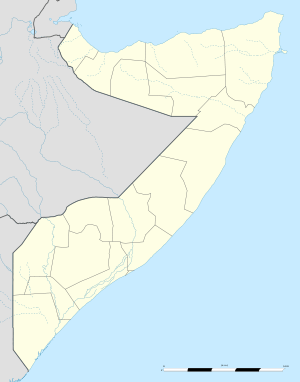Luuq
Luuq (Somali: Luuq, Arabic: لوق) is a town in the southwestern Gedo province of Somalia. It is one of the older settlements in the area. It is the seat of the Luuq District. The town is located in a bend of the Juba River, where the watercourse flows down from north to south in a horseshoe shape. Luuq is also known as Luuq Gan naane.
Luuq Ganaane | |
|---|---|
Town | |
 The town Luuq on a half island of Juba river | |
 Luuq Location in Somalia | |
| Coordinates: 3°41′53″N 42°35′50″E | |
| Country | |
| Region | Gedo |
| District | Luuq |
| Population | |
| • Total | 134.000 |
| Time zone | UTC+3 (EAT) |
Overview
The name Luuq in the Somali language means "alley" by virtue of the city's geographical setting. Luuq is one of the most jaw dropping settlements on Earth, with a river surrounding it from every corner except for a gap in the far south, which frees one from the rivers enclosures. The river has great influence on the city and its surrounding areas. The entrance of the city gate is situated not more than 100 meters from the river banks on both the eastern and western sides of the town. About 4 km past the city center and main Luuq Market, the river encloses the city again completely.
Historically, Luuq is one of the oldest settlements in Somalia. In his 1811 report to the authorities of British India, captain Thomas Smee wrote Luuq had 300 huts, in comparison to Mogadishu which at the time had between 100 and 150 stone houses.[1] Beginning in 1893, Luuq was attacked by Ethiopian raiding parties travelling down the Juba only when the Italian explorers Vittorio Bottego and Ugo Ferrandi arrived in 1895 were the Ethiopian attacks successfully repelled.[2] Luuq came under indirect Italian control by 1907, and Italian interest in the town was serious enough for them to demarcate the only segment of the Somali-Ethiopian boundary in order to include Luuq as part of Italian Somaliland.[3] For decades, it was the political center of the Gedo region.
On March 7, 2011, Transitional Federal Government forces and allied militia captured Luuq from Al-Shabaab rebels, encountering little or no resistance.[4][5]
In 2013, Luuq and other settlements in the wider Gedo region were officially incorporated into the newly formed Jubaland autonomous state.[6]
Demographics
Luuq has a population of around 41,000 inhabitants.[7] The broader Luuq District has a total population of 185,703 residents.[8]
Climate
Luuq has a hot desert climate (Köppen climate classification BWh). It has two very short rainy seasons, in April/May and October/November, due to the passages of the Intertropical Convergence Zone. However, these two rainy seasons are extremely unreliable even vis-à-vis other similar hot and arid regions of the globe.[9] Averages high temperatures exceed 40 °C (104 °F) in March, the hottest month of the year. Averages high temperatures remain above 33 °C or 91.4 °F during July and August, the least hot months of the year. Averages low temperatures are always above 20 °C or 68 °F throughout the whole year. Annual average rainfall is only 272 millimetres or 10.71 inches and the city receives just too little annual rainfall to achieve a “semi-arid” climate classification. Luuq is one of the hottest places year-round on Earth as the annual daily mean temperature exceeds 30 °C or 86 °F. The sky is almost always clear year-round and fair weather is extremely reliable.
| Climate data for Luuq | |||||||||||||
|---|---|---|---|---|---|---|---|---|---|---|---|---|---|
| Month | Jan | Feb | Mar | Apr | May | Jun | Jul | Aug | Sep | Oct | Nov | Dec | Year |
| Average high °C (°F) | 38.6 (101.5) |
39.6 (103.3) |
40.5 (104.9) |
38.3 (100.9) |
36.0 (96.8) |
35.0 (95.0) |
33.5 (92.3) |
33.8 (92.8) |
36.0 (96.8) |
37.1 (98.8) |
37.5 (99.5) |
37.8 (100.0) |
37.0 (98.6) |
| Daily mean °C (°F) | 31.5 (88.7) |
32.3 (90.1) |
33.2 (91.8) |
31.8 (89.2) |
30.3 (86.5) |
29.5 (85.1) |
28.2 (82.8) |
28.2 (82.8) |
29.6 (85.3) |
30.5 (86.9) |
30.5 (86.9) |
30.5 (86.9) |
30.5 (86.9) |
| Average low °C (°F) | 23.8 (74.8) |
24.5 (76.1) |
25.3 (77.5) |
25.0 (77.0) |
24.8 (76.6) |
23.8 (74.8) |
23.1 (73.6) |
22.6 (72.7) |
23.5 (74.3) |
23.7 (74.7) |
23.7 (74.7) |
23.0 (73.4) |
23.9 (75.0) |
| Average rainfall mm (inches) | 1.0 (0.04) |
1.0 (0.04) |
18.0 (0.71) |
82.0 (3.23) |
52.0 (2.05) |
2.0 (0.08) |
2.0 (0.08) |
1.0 (0.04) |
3.0 (0.12) |
48.0 (1.89) |
50.0 (1.97) |
12.0 (0.47) |
272 (10.72) |
| Source: Luuq Climate[10] | |||||||||||||
Notes
- Edward A. Alpers, "Muqdisho in the Nineteenth Century: A Regional Perspective", Journal of African History, 24 (1983), p. 444
- I.M. Lewis, A Modern History of Somalia, fourth edition (Oxford: Currey, 2002), p. 57
- Lewis, Modern History, pp. 88f
- Guled, Abdi (2011-03-07). "Somali president claims victory in war with rebels". Seattle Times. Associated Press. Retrieved 2011-03-07.
- "Somali troops, militia take two towns from rebels". Reuters. 2011-03-07. Retrieved 2011-03-07.
- "Somalia: Jubaland gains recognition after intense bilateral talks in Ethiopia". Garowe Online. 28 August 2013. Archived from the original on 12 October 2013. Retrieved 11 September 2013.
- "Somalia City & Town Population". Tageo. Retrieved 4 October 2013.
- "Regions, districts, and their populations: Somalia 2005 (draft)" (PDF). UNDP. Retrieved 21 September 2013.
- Dewar, Robert E. and Wallis, James R; ‘Geographical patterning of interannual rainfall variability in the tropics and near tropics: An L-moments approach’; in Journal of Climate, 12; pp. 3457-3466
- "Luuq Climate" (PDF). River Atlas Files. Retrieved 4 November 2011.